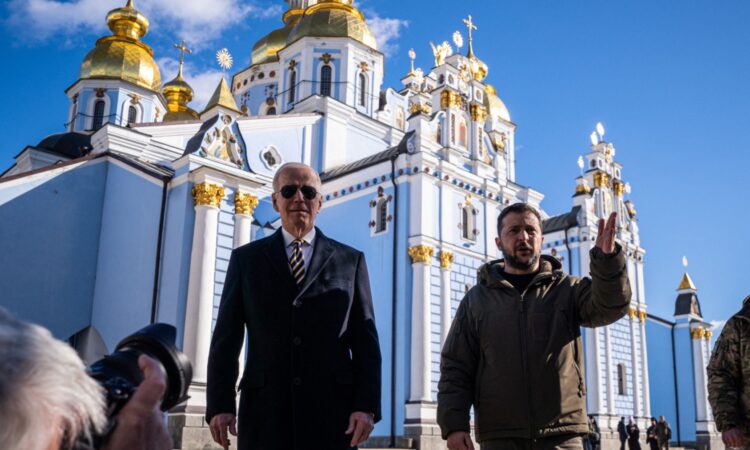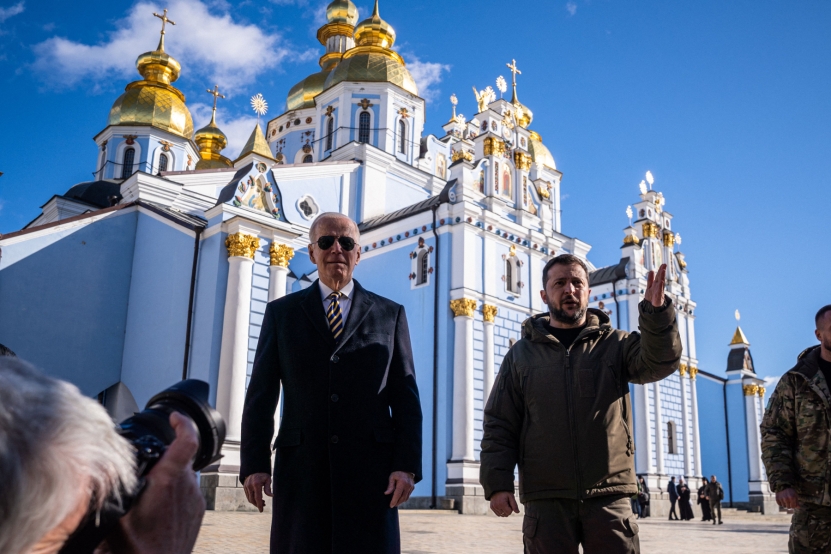

Dimitar Dilkoff/AFP via Getty Images
President Joe Biden arrived in Ukraine’s capital city of Kyiv on Monday in an early morning surprise visit to underscore American support for President Volodymyr Zelensky and his war efforts against Russia. Shrouded in secrecy, and coming days before the first anniversary of Russia’s invasion, the trip marks the first time Biden has traveled to Ukraine as president.
“One year later, Kyiv stands. And Ukraine stands. Democracy stands,” Biden said.
Armed with billions of dollars’ worth of weapons from Western countries, and in desperate need for more, Ukraine has fought the Russians to a bloody standstill. Despite American sanctions and the devastating battlefield losses of people and equipment, Moscow continues its assault on Ukrainian defenses.
Jake Sullivan, the president’s national security adviser, told reporters that the White House alerted Russian officials to Biden’s trip to Kyiv several hours before he arrived for “deconfliction purposes.”
Multiple government agencies and officials in the U.S. and Ukraine did not immediately respond to Rolling Stone’s inquiries about Biden’s trip. A senior White House official and a U.S. government official with knowledge of the trip confirmed the visit on condition of anonymity because they were not authorized to speak publicly.
Despite claims from the White House for Biden having “no plans” to cross into Ukraine during his trip to Poland, plans to cross the Polish-Ukraine border began more than a month ago, after Biden told staffers he wanted a public display to show solidarity between the United States and embattled Ukraine as it enters its second year of war. Politically, this trip “needed to happen,” a senior White House official tells Rolling Stone. Over the past year, First Lady Jill Biden, Defense Secretary Lloyd Austin, and others in the U.S. government have made the trip to the war-torn country while the president himself had not — until now.
On Monday, however, Biden strolled the streets of downtown Kyiv, with Zelensky at his side, and announced additional weapons deliveries.
“When Putin launched his invasion nearly one year ago, he thought Ukraine was weak and the West was divided. He thought he could outlast us. But he was dead wrong,” Biden said in a statement.
Biden was presented with an array of plans for this Ukraine trip, says the senior White House official with direct knowledge of the matter. The official was not authorized to speak on the record. One idea called for a meeting between Biden and Zelensky at an undisclosed location at the Polish-Ukrainian border. Another sought to hold the meeting in Lviv, a Western Ukrainian city that has been hit by Russian airstrikes several times since the war began but remains relatively safe when compared to the heavy fighting on the Eastern front.
Given the obvious fact that Ukraine is an active battlefield, both the Secret Service and the Defense Department had security objections to some of the plans presented. The Secret Service did not respond to Rolling Stone’s requests for comment, and the Defense Department referred questions to the White House.
The senior White House official says the concerns stemmed from the “unpredictability of the environment and the reduced security footprint required to support the movement of the president.”
Ultimately, Biden selected Kyiv, a city that stands as a symbolic gesture of Ukraine’s resolve after Russian forces tried and failed to capture the capital city early in the war last year.
Kyiv was seen as a key Kremlin objective when U.S. intelligence warned last year that the 150,000 Russian troops amassed on Ukraine’s border were set to invade. At the time, many in Ukraine and at home viewed the warnings as hype — or war-mongering. Then President Vladimir Putin launched his so-called “special military operation,” allegedly to cleanse the “Nazis” from his neighbor’s ranks. Outsider observers feared that Kyiv could fall to the Russians in a matter of days. Western governments offered to help Zelensky escape.
As Europe descended into bloodshed violence, the news broke that Zelensky told the White House mere days after Russia invaded: “I need ammunition, not a ride.” The war machine kicked in as Western countries sent multi-million dollar aid packages of bullets and bombs to Ukraine. They sent Javelin and Stinger missiles. Artillery batteries, and even some repurposed Soviet tanks. Combat videos of off-the-shelf drones dropping bombs on Russian soldiers and tanks littered social media.
The Russians have tried several counter-offenses, called up conscripts, and changed battlefield leadership over and over again. So far, it hasn’t worked.
“Russia’s much advertised offensive is more of a no-offensive,” retired Lt. Gen. Ben Hodges, who formerly served as head of U.S. Army Europe, tells Rolling Stone via email. “All they’ve done is add more poorly-trained, poorly-led conscripts to the meat grinder in a broad front approach that is much easier for the Ukrainians to defend than if there was in fact a real offensive where the Russians focused on one of two specific parts of Ukraine’s defense.”
Yet the Kremlin shows no sign of quitting as the war enters its second year. And the toll has been enormous — if a November estimate is true, 200,000 Russian and Ukrainian soldiers have been killed or injured per Gen. Mark Milley, the chairman of the Joint Chiefs of Staff. He also suggested that upwards of 40,000 civilians had died.
Last month, Rolling Stone reported on the intense fighting around the small city of Bakhmut in the Donetsk region of Ukraine. It’s trench warfare as Ukrainian soldiers fend off waves of Russian soldiers and hired guns from the Wagner Group, a nominally private military company run by Putin confidante Yevgeney Prigozhin.
In conversations with Rolling Stone, Ukrainian soldiers describe the scenes, saying that silence shatters to echoes of gunfire and falling artillery that slam into patches of dirt and infrastructure along the Svatove-Kreminna line. Calm moments can suddenly give way to the screams of wounded soldiers, filling the air like a symphony of destruction. Families and communities have been permanently shattered and displaced since this bloody affair began.
In Ukraine, fear looms large of shortages of ammunition and other material needed to continue the war.
“Ukraine can win this year if we are serious about it but the [U.S.] administration has not proposed a clear endstate,” retired Lt. Gen. Ben Hodges, who formerly served as head of U.S. Army Europe, tells Rolling Stone via email. “They lack clarity and the messaging is muddled, especially with regard to… the idea of winning.”
He adds: “Having said that, the administration has done a very good job bringing together more than 50 nations to support Ukraine.”
Biden’s trip to Kyiv occurs as Western leaders wrap up the Munich Security Conference, where questions linger over how this brutal war of attrition between Russia and Ukraine will end, if at all, and at what cost. Vice President Kamala Harris told conference attendees on Saturday that the United States had formally determined that Russian forces had committed crimes against humanity.
Complicating matters further, U.S. Secretary of State Antony Blinken on Saturday said the United States is concerned about the potential flow of weapons and ammunition to Russia by way of China. With U.S.-China relations already strained over the “spy balloon” fiasco, Blinken warned top Chinese diplomat Wang Yi of potential consequences, Reuters reported.
The Kremlin now claims it could throw 300,000 more troops into the breach — a force almost doubled in strength from what Moscow mounted last year.
Earlier this month, the White House said Biden also plans to meet with Polish President Andrzej Duda and other leaders from the region. Biden will deliver remarks ahead of the official anniversary on Feb. 24.
When asked how Russia would perceive Biden’s presence in Poland, Hodges says, “If the President uses the trip just to say, ‘We’re with Ukraine for as long as it takes,’ it will have been a wasted opportunity and the Russians will then know that we do not have the required sense of urgency or clarity of purpose to help Ukraine win this year. That would be a disappointment…I hope he’ll use it to lay out very clearly America’s strategic objectives for Ukraine.”
Jim LaPorta covers national security and military affairs. He is a former U.S. Marine infantryman and a veteran of the Afghanistan war. You can follow him on Twitter @JimLaPorta






